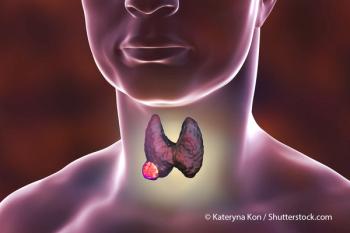
Clinical Management of Medullary Thyroid Carcinoma
In this interview on medullary thyroid carcinoma we discuss treatment strategies, prognostic biomarkers, surveillance following treatment, and more.
As part of Cancer Network’s coverage of the 86th Annual Meeting of the American Thyroid Association (ATA), held September 21–25 in Denver, Colorado, we spoke with Mimi I. Hu, MD, of the University of Texas MD Anderson Cancer Center in Houston. Dr. Hu is an associate professor and director of the center’s oncologic endocrine fellowship program.
- Interviewed by Bryant Furlow
Cancer Network: What sets medullary thyroid carcinoma (MTC) apart from other thyroid malignancies-and what distinguishes sporadic from hereditary MTC and other thyroid cancers?
Dr. Hu: MTC is very rare relative to the differentiated thyroid cancers (papillary, follicular, Hurthle cell) and thus requires a certain degree of experience from a patient’s provider to effectively counsel and manage patients with MTC. Additionally, one must be aware that genetic mutational testing for a RET proto-oncogene mutation is necessary for all patients diagnosed with MTC, regardless of whether there is any personal or familial history of other MEN2-related endocrine neoplasias, given that chance for de novo mutation and the implications with genotype-phenotype correlations.
I think one of the unique aspects of hereditary MTC is the implications for family members and need for genetic testing in first degree relatives and the added stress associated with that in addition to the adjustment to one’s own diagnosis of MTC.
Finally, MTC tends to have a very low chance for surgical cure once the disease has spread to loco-regional lymph nodes at diagnosis (which is different from differentiated thyroid cancer) and tends to be an indolent, chronic disease where patients and their providers must maintain long-term active surveillance for change. Learning to live with continued evidence of cancer is something MTC patients need to do.
Cancer Network: How have improvements in the understanding of MTC’s driver mutations, molecular pathways, and etiologies, affected treatment?
Dr. Hu: Understanding the drivers of MTC development, growth, and invasiveness has led to remarkable research activity in evaluating targeted agents for advanced and progressive MTC, such that within a decade two drugs (vandetanib and cabozantinib) were approved for progressive or symptomatic MTC and further studies are ongoing for other agents. Certainly, this is a huge benefit to our patients who historically had no treatment options. In addition, it has led to much-needed research interest in further understanding the pathogenesis of MTC with the intention of finding more effective treatments, which can potentially lead to the ultimate goal of cure or sustainable remission.
Cancer Network: What are important predictive or prognostic MTC biomarkers?
Dr. Hu: Poor prognostic markers are short calcitonin or carcinoembryonic antigen (CEA) doubling times of less than 6 months or development of the paraneoplastic syndrome, ectopic Cushing syndrome.
Cancer Network: What are the current first- and second-line treatment options for MTC? Is prophylactic thyroidectomy always indicated?
Dr. Hu: Surgery with total thyroidectomy with central compartment dissection is the most effective form of treatment, especially when MTC is diagnosed early and still confined to the thyroid gland. In patients with a RET germline mutations, prophylactic thyroidectomy is the standard recommendation to offer prevention of MTC development.
Cancer Network: What are the relative advantages and downsides to cabozantinib and vandetanib for treating MTC?
Dr. Hu: Tough question! The advantages to implementing medical therapy with either cabozantinib or vandetanib are, 1) to control disease growth by stabilizing or shrinking disease, which is important to prevent morbidity associated with progressive disease (such as postobstructive pneumonia, pain, etc) and, 2) to potentially control severe symptoms due to MTC, such as uncontrollable diarrhea/weight loss and Cushing syndrome.
The disadvantages include the significant side-effect profile of each drug. Every one of my patients knows that they are taking a drug that because of some side effect, requires daily monitoring and need for preventive therapies (eg, hand lotion, sunscreen, antihypertensives, antidiarrheals). Additionally, these treatments require chronic duration of use and patients can develop “treatment-fatigue” when they become tired of having to manage side effects chronically.
Cancer Network: What imaging or laboratory surveillance strategies are appropriate after initial treatment?
Dr. Hu: Laboratory testing for calcitonin and CEA levels are required after surgery to assess for postoperative response. Many providers forget that CEA is an important tumor marker to obtain along with calcitonin, as we recognize that a rapidly progressive CEA with relatively stable or low levels of calcitonin are suggestive of dedifferentiation or poor differentiation of the MTC, which is associated with more aggressive behavior. I typically check a calcitonin and CEA 3 months after surgery to catch the postoperative “nadir” of the tumor markers, as both markers can take a few weeks to clear after surgery.
Depending upon the postoperative calcitonin and CEA, I may need to evaluate for evidence of distant metastases, which typically include lung, liver, and bone. Per the ATA 2015 MTC guidelines, it is recommended that if the postoperative calcitonin is over 150, imaging with CT chest with contrast, CT abdomen with liver protocol, or MRI of the abdomen and MRI of the axial skeleton (spine and pelvis) and bone scan should be considered. It is important to emphasize that a PET-CT is not recommended to evaluate for distant metastatic disease.
Newsletter
Stay up to date on recent advances in the multidisciplinary approach to cancer.





